
Communities, Sport and Recreation
-
Community Partnerships and Priorities
- Aboriginal Partnerships
- Child and Youth Wellbeing
-
Community Policy and Engagement
- Advisory groups
- Centenary of ANZAC
- Companion Card Program
- Concessions Guide
- Prevention of Family and Sexual Violence
- International Women's Day
- Frank MacDonald Memorial Prize
- Significant Tasmanian women
- Tasmanian Honour Roll of Women
- Women on Tasmanian boards and committees
- Veterans Programs
- Seniors Card
- Tasmanian Carer Action Plan
- Older Tasmanians
- LGBTIQA+ Tasmanians
- Volunteering
- Multicultural Tasmanians
- Food Relief to Food Resilience
- People with Disability
- Women
- Community and Disability Services
- Community Grants
- Contact
- Digital Strategy and Services
- Office of Local Government
- Office of Parliamentary Counsel
- Office of Review and Evaluation
- Office of the Secretary
- Resilience and Recovery Tasmania
- Corporate and Government Services
- Policy Division
- Service Tasmania Unit
- State Service Management Office
Contact Details
By phone
Find the number of a specific division or office to contact them directly or call Service Tasmania on 1300 135 513.
Our staff
Use the Tasmanian Government Directory to find staff contact details
Social media
Follow our social media accounts to keep up to date with specific programs and initiatives.
Corporal John Joseph Button
Wanting a photo of a grave far away
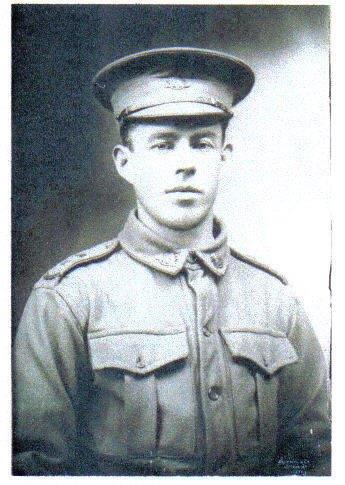
“I received word a stone has been erected on my late son’s grave. I paid for his name so I would very much like to receive a photo of my dear son’s grave”.
- - Kate Button, Perth, Tasmania 5 May 1924
Widow Kate Button was like many mothers who had lost their son during World War One – she wanted to see a photo of his grave and send seeds and bulbs to plant at the gravesite.
Taking photos of the war graves was a slow process. On 25 August 1919, the Officer in charge of base records replied to Mrs Button, that:
“…in all cases photos are being taken as speedily as possible and when copies are available they will be forwarded to this office for transmission to the soldier’s family.”
On 5 May 1924, Mrs Button had still not seen a photo of the grave of her only son, Corporal John Joseph Button, who was wounded at Villers-Bretonneux in France on 16 August 1918, and died of wounds at the 55th Clearing Station that day.
After World War One, the cost of travelling from Australia to Europe to visit graves of the fallen was prohibitive, equivalent to a working man’s wage for one year.
Date set to visit Corporal Button’s grave
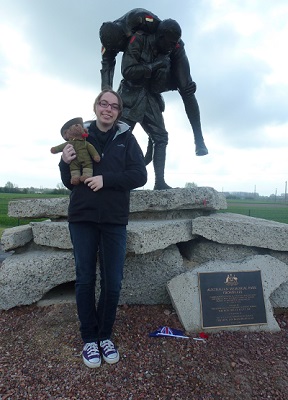 In
2012, one of Corporal John Joseph Button’s relatives was given an opportunity
to visit the gravesite. Marist Regional College student, Jacqueline Smedley,
was selected to travel to Europe as a member of the Frank MacDonald Memorial
Study Tour.
In
2012, one of Corporal John Joseph Button’s relatives was given an opportunity
to visit the gravesite. Marist Regional College student, Jacqueline Smedley,
was selected to travel to Europe as a member of the Frank MacDonald Memorial
Study Tour.
Students chosen for Frank MacDonald Memorial Study Tour are required to research a soldier in order to build understanding of Tasmania’s veterans and role in military history.
Jacqueline’s family tree provided plenty of soldiers to research, more than her family initially realised.
Jacqueline’s great-great-uncle Monte Edward Button died of wounds in 1917. Corporal James Button was killed in action in 1917 in Belgium. His cousin John Joseph Button, of Perth, was also killed. James’ brothers Ernest and Herbert served on the Western Front but survived.
Research about Corporal John Joseph Button
Jacqueline Smedley travelled to France armed with plenty of research about Corporal John Joseph Button:
- Date of birth: 26 September, 1889, Perth, Tasmania
- Family: son of Joseph and Catherine (nee Bolton) Button; brother to Elizabeth, Charles and Susan; one child, Cyril James, born 27 May 1909 with Jane Rosetta Bird
- Next of kin: Mrs Catherine (Kate) Button, Perth, Tasmania (mother)
- Occupation: Labourer
- Physical appearance: height: 5 feet 10 inches; weight: 168lbs; complexion: dark; hair: black; eye colour: grey
- Religious denomination: Church of England
- Service number: 1785
- Date of enlistment and age: 12 June, 1915; aged 24 years
- Rank: Private, then Corporal
- Unit: 26th Infantry Battalion 2nd Reinforcement; transferred to 2nd Australian Pioneer Battalion
- Date of embarkation: 17 July, 1915
- Name of ship and port: HMAT Orsova, ex Melbourne (A67)
Service details for John Joseph Button:
- Left Australia in July 1915 and after training in Egypt, was sent to the Gallipoli Peninsula on the 18 October 1915. The 26th Battalion was responsible for the defence of Courtney’s and Steele’s Posts and Russell’s Top, and was withdrawn from the peninsula on the 12 December 1915.
- Disembarked Alexandria, the Allies’ major naval base, for the Mediterranean, ex Mudros, a small Greek port on the island of Lemnos, on the 9January 1916. On return to Egypt, the A.I.F. was reorganised into two corps, I and II ANZAC, which replaced the original Australia and New Zealand Army Corps (ANZAC), of which John Joseph was a member.
- On the 13 March 1916, he transferred to the 2nd Australian Pioneers. He arrived in France on the 26 March 1916, where the 2nd Division was heavily involved in the Somme offensives, the first major battle being at Pozieres in July.
- In early 1917, the Division was involved in pursuing the Germans to the Hindenburg Line and the successful defence of Lagnicourt.
- 1917 also involved battles around Bullecourt, Menin Road and the capture of Broodseinde Ridge in October. They were the last Australian Division to be withdrawn from the Western Front.
- On the 13 April 1917, he was appointed Lance Corporal. On the 7 May, 1917, he obtained the position of Corporal. He attended 1st Anzac Corps School from the 22July until the 11 August 1917.
Work on the Western Front
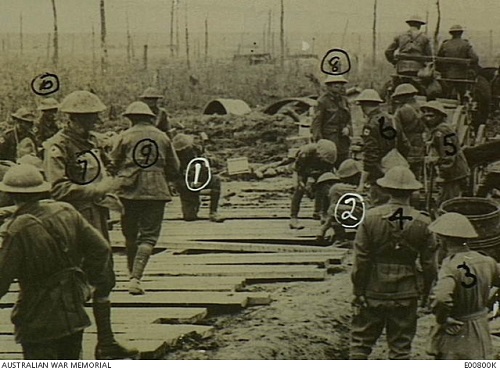
- Lance Corporal John Joseph Button is identified as number 10 in this photo of the 2nd Australian Pioneer Battalion making a wagon track from planks of wood around the Menin Road area at Chateau Wood (Ypres Sector) to allow further advance over freshly captured ground. Australian War Memorial photo ‘E00800K’ dated 26 September 1917.
Absent without leave and hospitalisation
- John Joseph had several episodes of ‘absent without leave’ and ‘hospitalisation’ throughout his years of service. One example was on the 14 May 1916, where from 6-9 pm he was absent without leave and subsequently forfeited five days’ pay.
- In February 1918, he went on leave to England where he was hospitalised for a period of time. His sister, Susan Mary, wrote to the War office in 1918 enquiring about his wellbeing:
“I trust you will do all you can to find out how he is and do you think we could get him home now? He is 2 years and 9 months there and done some very hard fighting. I hope you will do all you can in your power to help us in our trouble.”
- After being absent for some months, John Joseph was returning to his unit when he was hit by a shell near Villers-Brettoneux. He was admitted to the 7th Australian Field Ambulance and transferred to the 55th Casualty Clearing Station where he subsequently died of wounds the same day.
- Date of Death: 16 August 1918
- Cause of Death: “Had just returned from leave when he was hit by a shell at mid day on returning to his Unit. He had his arm blown off and he died at the same D/Station.” He also attained shell wounds to his right thigh.
- Place of Burial: Daours Communal Cemetery Extension, France. Daours is situated approximately 10 kilometres east of Amiens and is north-west of Villers-Brettoneux. There are 1 231 Commonwealth servicemen buried or commemorated in the Daours Communal Cemetery Extension which was designed by Sir Edwin Lutyens.
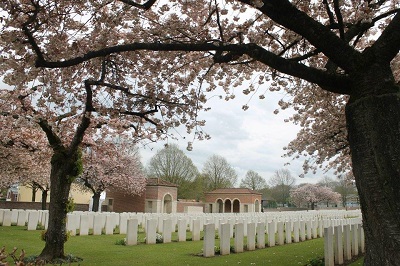
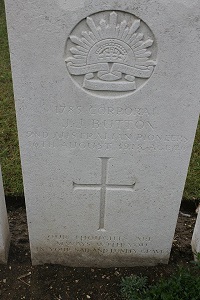
Illness
Unfortunately, Jacqueline did not have the privilege of visiting John Joseph’s grave at Daours Communal Cemetery Extension also at Amiens, France, due to illness. While Jacqueline was recuperating, other members of the Frank MacDonald Study Tour visited Corporal John Joseph Button’s grave and took a photo of the headstone that his mother so longed to see in the years after the war.
Jacqueline’s personal reflection:
As his family noted in his death notice, “deeply regretted, rest in peace, a hero and a man; he nobly did his duty.”
Fond are the ties that are broken,
Dear is the one that is gone,
In memory we will keep him,
As long as the years roll on
Rest in peace John Joseph.
Open Jacqueline Smedley’s research about Corporal John Joseph Button cousin’s
Read about other Frank MacDonald Memorial Study Tour pilgrimages
